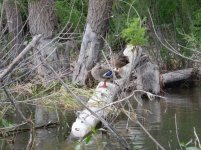The answer for me is absolutely never does my paddle (straight wood ottertail or carbon bent) ever pry or touch my canoe in any manner unless it is laying inside the hull, when not being used. My solo power stroke with vertical shaft, both hands "stacked" over the water, goes from the catch in front of me, gradually morphing from straight back power into a pitch stroke, with a partial "C" as might be necessary. The pitch eliminates any necessity to ever need anything more a slight quick non hesitating J correction, then immediately into a feathered air recovery without ever touching the canoe at any point. Only if in a sharp onside turn, a more radical outward push to a ruddering J hold might be needed, with blade held well out away from the boat, never touching it.
If not in racing or training mode, what would in that have been a slight ending J instead will become a Canadian recovery and correction stroke, power face of the blade facing up.
When I train new paddlers, I was taught to push their boat into a glide and have them discover what happens when they drag the paddle in J (or rudder) orientation mode with the blade held down at a slightly rotated angle relative to vertical. When it is fully under water near the stern, you can make the boat bow yaw in either left or right direction until you apply a normal vertical blade J pushed at a slight outward angle to make the bow drift toward the onside.
I have seen photos of Bill Mason's padle shaft nearly worn through from draggiing it on the gunwale, so in some schools that is obviously ok. I learned differently.


